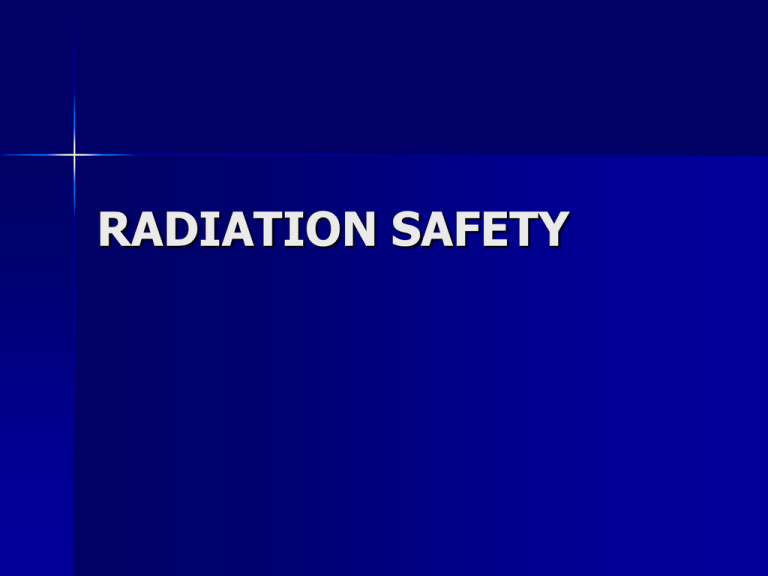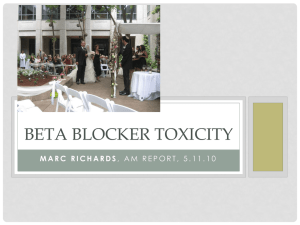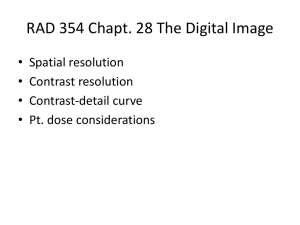RADIATION SAFETY - Risk Management
advertisement

RADIATION SAFETY Definitions Roentgen – RAD – 2.58 x104 coulombs/kg air Radiation Absorbed Dose- Density dependant (to convert roentgens to rads you must include a density factor) REM – Roentgen Equivalent Man REM RAD * Q factor = REM GRAY * Q factor = Sievert Definitions Gray = 100 RAD Sievert = 100 REM Definitions Curie = 3.7 * 1010 dps – cps vs dps Becquerel = 1 dps Definitions Linear Energy Transfer (LET) – Energy given up per unit distance traveled Specific Ionization (SI) – – Ion pairs formed per distance traveled Note a high LET or SI gives greater radiotoxicity LET or SI + + + _ _ + + _ _ _ + _ Definitions Background Radiation – Erythema Dose – 1-2 msieverts/year 1 gray to the skin LD50 – 5 gray whole body exposure Definitions ALARA As Low As Is Reasonably Achievable – Because we don’t know – ALARA Continued While the regulatory limit is 50 msievert per year (about 12.5 msievert/quarter) At BYU I will investigate any quarterly dose above 100 mrem (1 msievert) Definitions Gamma ray – – – Origin Nucleus Low mass, charge Low LET Definitions X-ray just like gamma but origin is an electron Beta Particles – – Mass and charge = electron high LET KERMA = kenitic energy released per unit mass Definitions Electron capture Beta Decay Alpha Decay Definitions Total Effective Dose Equivalent Cumulative Committed Effective Dose Equivalent Deep Dose Equivalent Biological Effects Acute Chronic Biological Effects Direct chemical damage due to ionization of important biological molecules Most damage is done by radical formation – the most common is the hydroxyl radical H2O + radiation > H+ + OH (unpaired electron) Biological Effects Acute Biological Effects Erythema (skin gets red) 1 gray Bone Marrow and white blood cells destroyed (about 5 gray or 500 RAD) this is the LD50. Ionizing radiation is a “metabolic poison” it preferentially damages rapidly metabolizing cells. Gi tract -10 to 20 gray whole body (death certain) CNS is destroyed at 50 gray and above Biological Effects Chronic Biological Effects Cancer Mutations Teratogens Biological Effects DNA Damage RNA Damage Enzyme Damage NOTE: Damage to DNA is amplified through transcription and replication excess cancers (lifetime) Dose Response 20 15 10 Series1 5 0 0 0.5 1 Exposure (sieverts) 1.5 Biological Effects Linear No Threshold Theory states that if the dose is doubled the risk of toxic effects (due to ionizing radiation) is doubled – Not definitively demonstrated at low doses – Not applicable to acute dose, applicable to stochastic or random events like cancer – Always RBE (rem or sievert) Biological Effects Internal vs External Hazard (epithelial barrier) Some nuclides can only hurt you if they get inside you. Examples low energy beta emitters such as 35S, 3H, 14C and alpha emitters Radiotoxicity – LET, Target Organ, Effective Half Life Interactions (Photons) Compton scattering Photoelectric effect Pair Production Half Value Layer Interactions (Beta Particles) Bremsstraahlung Ionization Range Interactions (Beta Particles) Bremsstraahlung (x-rays) – – Increased by high atomic number materials Increased by high energy electrons Nuclide Characteristics Tritium 3H Very Low energy –Beta emitter Cannot be detected with Geiger Counter LSC and Gas proportional counters 12 year half-life 6 keV Nuclide Characteristics 35S and 14C Low Energy Beta 10 percent 2pi efficiency 87 day half-life 50 keV, range in air 22 cm Nuclide Characteristics 32P High energy – bremsstraahlung GM detector gives high efficiency 14.29 days half life 700 keV energy, range in air 6 meters LET is inversely proportional to energy Nuclide Characteristics • • • • • 125I Gamma emitter low energy (electron capture) Target organ – thyroid 60 day half-life Solid scintillation is best detection method Nuclide Characteristics 33P Low energy beta emitter 27 day half life 14C low energy beta emitter 5000 year half life Waste Disposal Decay Sewer Ship Chemicals Management 2-6156 (characterization) Waste Disposal Decay – – Half life less than 90 days Remove all labels Waste Disposal Sewer – – – – – 100 microcuries 100 microcuries 100 microcuries 100 microcuries No Iodine of of of of tritium 35S 14 C 32P Waste Disposal Remove all labels List Nuclide Note quantity Waste Disposal Liquids must be in Plastic leak proof containers Solids should be in a closed plastic bag List laboratory Waste Disposal Never mix hazardous chemical wastes with radioactive wastes without RSO Approval Never mix short half life nuclides with long half life nuclides without RSO approval Get approval from the RSO before using radioactive isotopes in animals Dosimetry TLD badges for external hazard materials Significant Quantities – – Over 2 millicuries in one package Over 3 millicuries in one month Dosimetry Thermoluminescent Dosimetry – Heat Wear the badge on or near your lapel Wear ring badge with TLD crystal to the inside (exposed) portion of your hand Wear fetal badge near stomach Iodinations E 238 BNSN Perform thyroid assay before, following and 24 hrs later Use RSO’s survey meter Keep results in your book and send them to the RSO Bioassay If you handle 5 mCi or more you will do bioassays Bioassays required for all iodinations – Solid Scintillator – Urine (early morning – 1 ml count one minute) Leak Check All new material should be leak checked prior to use Call the RSO if a leak is detected Protection Time, Distance, Shielding and Quantity Use Personal Protective Equipment – Gloves, goggles, lab coat Eating and Drinking Never eat, drink or apply makeup in a laboratory authorized for use of radioactive isotopes Regulations R313-15 and R313-18, 10 CFR 20, License Allowable Exposure 5 Rem/Year Pregnancy 500 mrem/pregnancy Regulations The University has an obligation to the pregnant woman and her unborne baby. But this obligation begins with a formal (written) declaration of the pregnancy. Regulations Security – – Locked Up –double locks Under personal supervision of an authorized individual Regulations Required Notice – DRC04 must be posted – Dosimetry Report annually. Instrumentation Ionization Chamber Gas proportional counter Geiger Mueller counter Laboratory Surveys Survey your laboratory each day that isotopes are in use Log the survey values Identify the survey meter and person Instrumentation + _ + _ _ + Gas Filled Chamber Electronics Instrumentation Solid Scintillator – Most sensitive for photons (required if you use 125I) Liquid Scintillation – 4 π geometry – Tritium detection Instrumentation Efficiency – – – Geometry - surface area of a sphere =4π r2 Coincidence Window Instrumentation Calibration must be completed at least annually. – Photon detectors must be sent out – Beta survey instruments may be calibrated by Risk Management Laboratory Surveys Check hands, telephone, bench, floor in front of bench, soles of shoes, computer keyboard, centrifuges, door handle Survey at the end of each day that rad material is used. Be prepared to calculate surface contamination Laboratory Surveys Documentation – Date – Instrument SN – Battery check – Check Source count – ID of person completing the survey – Survey result – Anything above background is positive Laboratory Surveys Important variables – Nuclide energy – Distance from the surface – Speed of detector movement – Audible is more sensitive than instrument reading Documentation Receipt logs Disposal logs Survey logs Documentation Certification User Authorization Facility Authorization Training list Emergencies Call 2-2222 if no risk of life or health Call 911 if risk of life or health Emergency Procedures Get Help - Emergencies call 911 on a campus phone If help is needed immediately call 22222 Radiation Safety Officer 2-4468 Emergency Procedures First priority Human life and safety Second priority limit the spread (consistent with first priority) – Clean the spill up – Block off the area – Survey for contamination on yourself and the ‘clean areas around you’ pay particular attention to your shoes.







